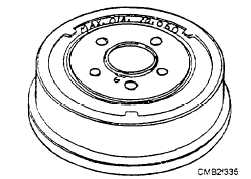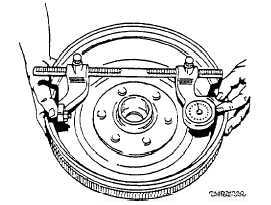Are the brake shoes centered on the backing plate and contacting the anchor pin correctly?
Are all springs installed properly?
Does the automatic adjusting mechanism work?
Are the linings perfectly clean (sand if needed)?
Do I need to bleed the brakes?
Servicing Brake Drums
With the drum removed, inspect the shoes to determine the condition of the drum. For instance, if the linings are worn thin on one side, the drums are likely to be tapered or bell-shaped. Linings with ridges in their contact surfaces point out the need for resurfacing (turning) the drum to remove the matching ridges.
Resurfacing is needed when the drum is scored, out-of-round, or worn unevenly. Some shops resurface a drum anytime the brake linings are replaced, others only when needed. Drums are resurfaced using a lathe in the machine shop of an NMCB and at some shore installations. Commercial brake drum lathes can be found in some shops. Make sure you know how to operate the lathe before attempting to resurface a drum. Using the wrong procedures will damage the drum and possible deadline the vehicle.
Before resurfacing the drum, check the specifications that are cast into the drum (fig. 7-34) or are provided in the maintenance manual. These specifications tell you the maximum amount of surface material that can be removed from the drum and still provide adequate braking. Typically, a brake drum should not be more than .060 inch oversize. For esample. a drum that is 9 inches in diameter, when new, must not be over 9.060 after resurfacing. To measure brake drum diameter, use a special brake drum micrometer (fig. 7-35). It will measure drum

Figure 7-34. - Example of specification cast into a brake drum.

Figure 7-35. - Using a drum micrometer to measure a brake drum.
diameter quickly and accurately. Replace the drum if it is worn beyond specifications.
For maximum braking efficiency after the drums have been resurfaced, the arc of the shoes must match the drums. This means that the linings must be ground to match the curvature of the drum when it is resurfaced. There should be a small clearance between the ends of the lining and the drum. The shoes should rock slightly when moved in the drum. If the center of the linings is not touching the drum, the linings should be arced (ground). Shops equipped with a commercial brake lathe have a special attachment to perform this task. If no attachment is available, the shoes can be installed but the brakes will not become fully effective until the linings wear enough to match the braking surface of the drum. Frequent adjustments will be needed until they wear sufficiently.
SERVICING DISC BRAKES
All disc brake services begin with sight, sound, and stopping test. The feel of the brake pedal adds a check on the condition of the hydraulic system.
Stopping the vehicle will indicate whether the brakes pull in one direction, stop straight, or require excessive effort to stop. Listening while stopping permits a fair diagnosis of braking noises, such as rattles, groans, squeals, or chatters. Visually inspecting the parts provides valuable information on the condition of the braking system.
A complete disc brake service typically involves four major operations, which are as follows:
Replacing worn brake pads
Rebuilding the caliper assembly
Resurfacing the brake discs
Bleeding the system 7-29Continue Reading
